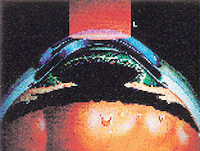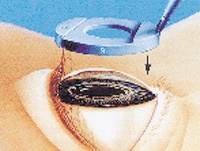Beware of retinal tears during LASIK for myopia
Retinal tears or holes may put refractive surgeons at risk for complications and poor post-LASIK quality of vision.
The prevalence and causes of myopia have been the topics of many investigations since the 1960s. Researchers have demonstrated an increase in the prevalence of myopia in the population over a relatively short period of time, fueling debate about the relative contributions of heredity vs. environment to rates of myopia in the population.
In the absence of effective primary prevention techniques to control an increase in the incidence of retinal tears and holes in myopic eyes, refractive surgeons are at risk for having complications and causing poor quality of vision in many eyes through laser in situ keratomileusis (LASIK). LASIK and photorefractive keratectomy (PRK) have been shown to be reliable for correction of low to moderate amounts of myopia.
It is essential that the refractive surgeon have an accurate understanding of the natural course of adult myopia. This knowledge, as well as knowledge of long-term surgical results, is crucial to surgery planning and patient counseling regarding the advisability of initial surgery and augmentation surgery. Because most long-term studies of refractive surgery do not include a control group, to interpret the data one must have an understanding of normal anatomy and pathology of the retina and the consequences of the high-pressure suction ring used in LASIK.
Patients and methods
 ---Identification of all retinal breaks (T) is fundamental for refractive surgery without complications. (L=laser application)
---Identification of all retinal breaks (T) is fundamental for refractive surgery without complications. (L=laser application)
All published reports of myopia prevalence in adults were reviewed, as well as the prevalence in retinal detachment by retinal tears. Approximately 100 eye records were analyzed to identify 83 eyes with 1 D to 6 D of myopia and 17 eyes with 6.25 D to 10 D. Amounts of myopic shift (an increase of 0.1 D of myopia) were identified and analyzed within the population. All patients were evaluated under biomicroscopy, and retinal evaluation by funduscopy was performed to identify possible retinal tears or holes before excimer laser treatment. The results were compared with long-term studies.
To estimate the presence of retinal tears and the possibility of a retinal detachment in myopic eyes under excimer laser treatment with the LASIK technique, we examined the records of 100 myopic eyes of patients who entered our practice. Both medical and photographic files were examined for these patients. The 100 eyes were reviewed under the diagnosis of myopic retinal tear. Rhegmatogenous retinal detachment was defined as a localized serous elevation of the neurosensory retina associated with retinal tear(s) or hole(s) and subretinal fluid, mainly caused by traction on a fragile area of the peripheral retina by diverse causes.
The following information was analyzed: history of present illness; complete medical and ocular history including prior surgeries; medications; best-corrected visual acuity; refractive error; Amsler-grid responses; slit lamp biomicroscopy; fundus ophthalmo scopy; and ophthalmoscopic findings.
Photographic files were examined to characterize and locate the neurosensory detachment, tears and subretinal fluid if present. Patients had no other known ocular or systemic disease but myopia to cause the retinal pathology.
Results
 ---The suction ring that fixates the globe during LASIK can induce intraocular pressure of 65 mm Hg or more.
---The suction ring that fixates the globe during LASIK can induce intraocular pressure of 65 mm Hg or more.
This study of people aged 18 to 55 years showed that 83% had low myopia (less than 6 D) and 17% had moderate to high myopia (6.01 D to 10 D). A single excimer laser scanning system was used for the entire group of patients.
We identified 12 patients who were diagnosed with severe myopic chor oid-opathy. Five patients (9 eyes) were ex cluded because of inadequate follow-up (n = 7) or coexisting ocular disorders (n = 2). Two patients (2 eyes) had a rhegmatogenous retinal detachment in a period of 3 to 4 weeks after excimer laser treatment, possibly because of un-identified retinal lesions before surgery.
The average age was 36 years, with a range of 18 to 55 years. The average length of follow-up was 1.25 years, with a range of 0.1 to 14.5 months. The most common symptoms were positive diminishing visual acuity (3%) and/or blurred vision (2%). Metamorphopsia (1%), photopsia (3%) and micropsia (1%) were described less frequently.
The average size of neurosensory retinal detachment was 2.5 disc areas, with a range of 1 to 6 disc areas. None of the eyes with retinal detachments in this study involved the fovea. Both eyes with retinal detachments were within 1 disc area from the center of the fovea.
Uncorrected visual acuity was 20/40 or better in 100% of eyes after retinopexy. We failed to identify whether residual myopia was due to LASIK or was induced by retinopexy.
Cryocoagulation was used in both cases because of the presence of subretinal fluid surrounding the retinal tear. The retinal tear was characterized by episodes of serous retinal detachment followed by small areas of retinal pigment epithelial atrophy.
For Your Information:
- Samuel Boyd, MD, can be reached at Boyd Eye Clinic, PO Box 1189, Panama, 1, Panama; +(507) 264-8011; fax: +(507) 263-9417; e-mail: sboyd@hophthal.com. Dr. Boyd has no direct financial interest in any of the products mentioned in this article, nor is he a paid consultant for any of the companies mentioned in this article.
